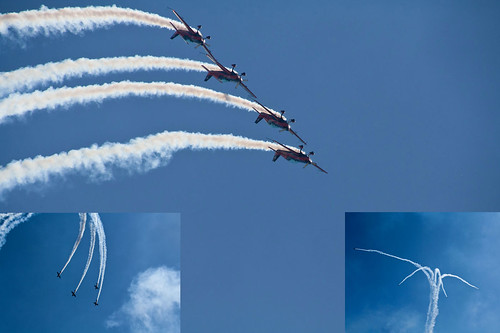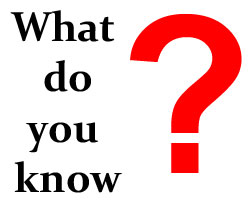
• Air Display Montage •
Entered in a competition as three projected digital images today
Click image to view large
• Air Display Montage • By Netkonnexion on Flickr ![]()
Competition is fun and improves your photography.
The essence of improvement is getting feedback and learning from it. Photography is no different. Competition provides feedback and helps you streamline your technique. Improve for competition and you will improve for your viewers.
Is there a problem?
You would think so. I know lots of people who are really rather reluctant to enter competitions. The reasons for this reluctance tends to fall in to three categories:
I am waiting for the perfect picture to enter…
• Ever heard the saying, “Excellence is the enemy of good”? You can waste your whole life waiting for the right circumstance, picture, money, gift, break, whatever. In most cases excellence is only achieved by practice, application, focus and persistence. And, of course, lots of mistakes along the way. If you don’t start now you will never get to a position where you can consistently create excellence. To work toward something excellent in the long run work with the “good” now and test out your skills. If you work at it excellence will follow.
I’m worried someone may say something horrible about my work…
• No one likes to be criticised. Except that is when it is positive and a learning experience. In photography clubs the world over competitions happen all the time. Yes, they are competitive, but they are also learning experiences. Photographers go there to learn what they can do to match up to future competitions. Judges have no investment in crushing people. Judges try to enable more competitors to enjoy photography and improve their skills. When they talk about a picture they want to emphasise the good points and highlight the things that need to be considered in the light of experience. A good judge will make you feel great about successful aspects of your picture and help you learn about the less successful ones.
I worry my effort is shamefully bad and I will be a laughing stock…
• Children are cruel to each other. The playground is a hell of a place to learn tact and diplomacy. Yet, most of us do learn it. We are grown up now and this excuse does not hold water. Most of us have been through the university of hard knocks. Really this is just a throwback to childhood. There is nothing like just doing it… have a go! There is really nothing to be afraid about.
Who will I be up against?
• One of the great things about competitions is they are usually graded. If you are a beginner then get into the novice or starter class. If you have been doing competitions for years then go for it, enter into the advanced competition class. But exercise common sense. If you have never entered a competition, swallow your pride and enter the novice class. You need to know the way these things are played and the gentle approach will allow you to learn and do well. Get the lay of the land before your all out attack! joining a local photographic club is a good start.
Of course you may want to enter a national or international competition right out. Well, feel free. However, the stakes are higher and so is the field of entry. The “Veolia Wildlife Photographer of the Year”, now in its 49th year, usually has more than thirty thousand entries. It is a revered world-wide competition with big prizes. Of course there are far too many entrants to give feedback on them all. So my advice is to start small. Enter club or local competitions. You will be up against people who have similar talent levels. Even if your picture is not commented upon you can often find feedback on the winners photos that will help you see your own errors.
What is expected of me in a competition?
• Competitions are great at putting people on the same level. Everyone is treated the same. There is only one real expectation…
Enter your best picture that matches the brief for the competition
You would be surprised at how many people fall at that simple hurdle. Most beginners simply do not read the brief and provide a photograph to match it. If you want to win, you have to provide a photograph that the judges are looking for when they judge. Sounds simple. It does take some thinking about. The rules (example) and the guidance documentation (example) are essential reading. You should know them inside out. What you think about the rules is irrelevant. No mercy will be shown for people who do not fulfil them and the brief. The image will just be excluded. If you do everything the rules and the competition brief asks, then your picture will be reviewed.
 Photokonnexion tips by email
Photokonnexion tips by emailEnjoying this article? Please sign up for our
daily email service.
Find out more…
What will the judges be looking for?
The answer to this varies from competition to competition. Normally you can get a feel for it from the guidelines for the competition. However, as a general rule, the judging will cover the following sorts of criteria:
Fit to the brief
• Does the photo actually meet the competition requirements
Presentation: Overall Impression of the photograph…
• Editing, mounting (if mounted on something), printing (if a print)
Camera Work Technique: (photographic skill)
• Choice of viewpoint or angle taken to the subject
• Choice of lighting (should be appropriate for the subject)
• Accurate focusing
• Appropriate quality and choice of exposure
• Suitable depth of field (aperture)
• Appropriate use of shutter speed for the subject
• Highlights and shadows (ensuring detail is retained)
Technical Quality: (of prints or editing, finish etc)
• Absence of processing faults, dust spots, processing artefacts, image damage by sharpening etc.
• Appropriate tonal use and control of the range of tones
• Good image finishing
• Appropriate use of levels, curves and colour management (post processing)
Visual Awareness, Visualisation and Seeing:
• Composition, design and cropping of the images (aesthetic considerations)
• Appropriate simplification (minimising irrelevant complications)
• Distractions and intrusions should not divert the viewers eye
• Good use of light, mood, texture and colour
• Good use of masking and manipulation where appropriate (or where allowed) depending on the rules of the competition
Communication and meaning:
• Personal input, understanding of, and connection to the subject
• Appropriate communication of any message, mood, ideas, and information
• Complementary use of the photographic medium to suit the subject (mounting, projection, printing, texture of print substrate etc)
• Appropriate imagination and creativity as well as suitable timing for the shot
That is quite a list. It is a lot to take in. Some of the terms may not be familiar to you either. That is why you are advised to go through club channels to learn what is involved in these different processes.
What if I win?
• Congratulation are in order. However, there are usually some post competition issues to consider. For example often competitions put restrictions on what you can say to the press about the competition. You may also be required as a condition of entry to allow the competition organisers to be able to use your image in some way. Be sure that this use is compatible with your use of the image. Some commercial photographers have fallen foul of competition restrictions in the past. Again, the only guidelines you should follow are those of the competition. As to awards and prizes you will normally be told in the instructions for the competition what those are. They differ widely.
Finally…
I can only wish you luck. Competitions are great fun and I have learnt a huge amount from competing over the years at club and other levels. I think if you enter a competition you will learn too. It is all about improving your photography and having fun. If you join a club it will also be about doing it with your friends and with their help too.
Start Photokonnexion email subscription now!
Photokonnexion Photographic Glossary – Definitions and articles.
“Veolia Wildlife Photographer of the Year”
example
example
For more in depth points, see also: Competition Photography



